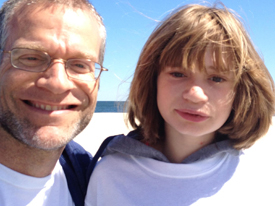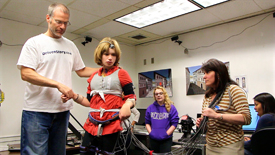Elizabeth Torres believes sensory and motor impairments of children on the spectrum may be the key to diagnosis and therapy
Could a team at Rutgers University revolutionize the way autism is diagnosed and treated? Elizabeth Torres, a Rutgers computational neuroscientist, thinks they can.

Torres and her fellow researchers have developed a method of measuring minute fluctuations in body movements to potentially reveal, as early as infancy, whether the developmental trajectory of a child is off the typical course, says Torres, who worked on the project with help from researchers at Indiana University.
“What’s happening now is there’s a score system to diagnose autism, but it’s extremely general,’’ says Torres, an assistant professor in the Department of Psychology, School of Arts and Sciences. It doesn’t include an objective way to measure the degree of impairment tailored to the individual child, she says.
Torres’s method, developed in the Rutgers Sensory Motor Integration Lab, uses a digital real-time map of the subject moving through space – at 240 frames per second – and can determine the exact degree to which these patterns of motion differ from more typically developing individuals.
Many children with autism have a severely impaired sense of how their bodies move and feel. They have a limited ability to connect their actions with their intentions, she says. For them, the simple act of pointing or reaching for an object can be a challenge or impossibility. “There is a disconnect in the way these children sense and perceive the physical world and the ways in which they integrate that information with their own body motions,’’ Torres says.
People without the disorder, she explains, can perceive their own physical behavior. "We have maps of our body in various parts of the brain that tell you, for example, where your foot is in relation to your hand, or when and where someone touched you. But for them, this information is corrupted. From moment to moment the timing of their motions is different. It’s like a radio tuned to the wrong frequency.’’
In 2009, Torres received a $650,000 grant from the National Science Foundation shared with Rutgers' Dimitri Metaxas, a professor in the Department of Computer Science. The two teamed up with medical and physics researchers at Indiana University to test and develop the technology, a study that ended in August.
The researchers also are working to refine a method of using computer interfaces to treat non-verbal children on the autism spectrum.

In Torres' studies, autistic children exposed to onscreen media – such as videos of themselves, cartoons, a music video or a favorite TV show – can learn to communicate what they like with a simple motion. “It’s kind of like the Wii, " Torres explains. "Every time the children cross a certain region in space, the media they like best goes on. They start out randomly exploring their surroundings. They seek where in space that interesting spot is which causes the media to play, and then they do so more systematically. Once they see a cause and effect connection, they move deliberately. The action becomes an intentional behavior."
According to the Center of Disease Control and Prevention, one in 88 children nationwide is on the autism spectrum. Torres believes that the autism community hasn’t paid enough attention to the sensory and motor impairments of children on the spectrum or recognized how it can be key to diagnosis and treatment.
"We have found ways to design therapies where one can help these children develop and improve their cognitive abilities,'' says Jorge Jose, a Professor of Integrative and Cellular Physiology at Indiana University, who is working with Torres.
“This is so unexplored. The way autism is studied is completely divorced from the body, even though this is a physical problem,’’ she says. “People should know how this could help.’’
Conventional therapies for autistic children, Torres says, may even be attempting to curb behavior that may be helping them in some way.